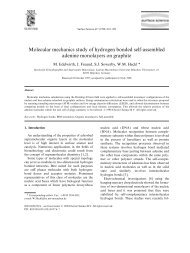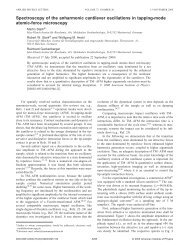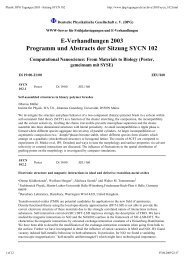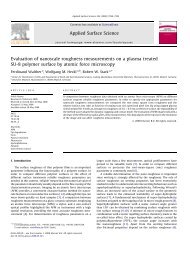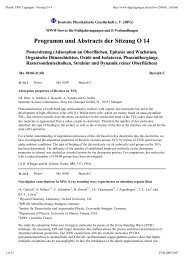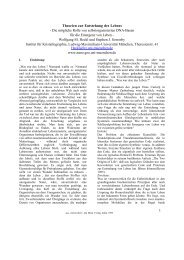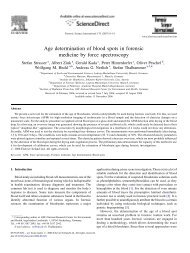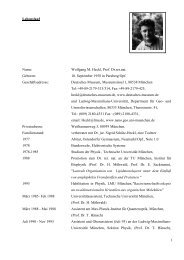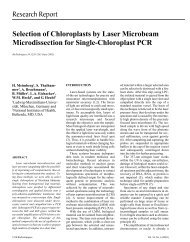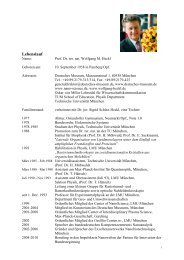Physik: DPG Tagungen - Sitzung O 28 - Nano-science.de
Physik: DPG Tagungen - Sitzung O 28 - Nano-science.de
Physik: DPG Tagungen - Sitzung O 28 - Nano-science.de
You also want an ePaper? Increase the reach of your titles
YUMPU automatically turns print PDFs into web optimized ePapers that Google loves.
<strong>Physik</strong>: <strong>DPG</strong> <strong>Tagungen</strong> - <strong>Sitzung</strong> O <strong>28</strong><br />
http://www.dpg-tagungen.<strong>de</strong>/archive/2004/o_<strong>28</strong>.html<br />
rule, while not contributing to the magnetization. Much less is known in the case of small clusters. We have<br />
<strong>de</strong>rived magnetic moments of superparamagnetic Co 55 clusters from XMCD at various applied magnetic fields.<br />
We find that the moments thus obtained from the magnetization curve and those <strong>de</strong>termined separately from the<br />
sum rules agree to within 10%. This result sets an upper limit for the importance of T z in these clusters.<br />
[1] B. T. Thole et al. , Phys. Rev. Lett. 68, 1943 (1992)<br />
[2] P. Carra et al. , Phys. Rev. Lett. 70, 694 (1993)<br />
O <strong>28</strong>.85 Poster Mi 16:00 Bereich C<br />
X-ray resonant magnetic scattering of Fe/Cr superlattices<br />
•Alexei Nefedov, Johannes Grabis, Andre Bergmann, Florin Radu und Hartmut Zabel<br />
Institut für Experimentalphysik/Festkörperphysik, Ruhr-Universität Bochum, D-44780 Bochum, Germany<br />
We have studied the magnetic and structural properties of an antiferromagnetically (AF) coupled Fe/Cr(001)<br />
superlattice by soft X-ray resonant magnetic scattering. Strong magnetic Bragg peaks are observed at the half<br />
or<strong>de</strong>r positions in reciprocal space parallel to the [001] growth direction and in between the structural Bragg<br />
reflections from the superlattice periodicity. The magnetic hysteresis loops measured at the structural Bragg<br />
peak and at the half-or<strong>de</strong>r peak clearly <strong>de</strong>monstrate the AF coupling of the Fe/Cr multilayer. Transverse scans<br />
and off-specular reflectivity measurements confirm an AF domain structure of the superlattice in remanence<br />
with large perpendicular correlation. In addition, the transverse scan of the half-or<strong>de</strong>r Bragg peak exhibits a<br />
Lorentzian line shape at zero field, which diminishes in higher fields, indicative for a remanent multidomain state<br />
which approaches a single domain state towards saturation.<br />
This work was supported by the German Fe<strong>de</strong>ral Ministry of Education and Research (BMBF) un<strong>de</strong>r Contract<br />
No.03ZAE7BO.<br />
O <strong>28</strong>.86 Poster Mi 16:00 Bereich C<br />
Inducing spin crossover in metallo-supramolecular polyelectrolytes through an amphiphilic phase<br />
transition<br />
•Yves Bo<strong>de</strong>nthin 1 , U. Pietsch 1 , D. Kurth 2 und H. Möhwald 2<br />
1 University of Potsdam, Institute of Physics, Am Neuen Palais 10, 14469 Potsdam, Germany<br />
2 MPI-KG Golm, Am Mühlenberg 1, 14476 Potsdam-Golm<br />
In the last years resonant magnetic X-ray reflectivity experiments (XMCD) become important for the<br />
investigation of molecular magnetism in thin films.<br />
In the present work we report a novel approach to affect spin crossover by introducing mechanical strain<br />
through an amphiphilic phase transition in a metallo-supramolecular polyelectrolyte-amphiphile complex (PAC).<br />
The investigated system consists of thin layers <strong>de</strong>posited in Y-conformation on a silicon substrate by means of<br />
Langmuir-Blodgett technique.<br />
It was observed by EXAFS, x-ray reflectivity and in-plane diffraction experiments that the structural phase<br />
transition in the amphiphilic mesophase is responsible for the distortion of the coordination geometry of the<br />
tightly coupled transition metal centres. Consequently, the energetic separation of the subsets of the iron<br />
d-orbitals changes and gives rise to spin crossover. Using temperature resolved SQUID and XMCD<br />
measurements we observe a diamagnetic to paramagnetic phase transition above room temperature which is<br />
connected to a structural phase transition between two liquid crystalline phases.<br />
[HOME] [E-Verhandlungen 2004] [Regensburg] [Fachverband O] [<strong>Sitzung</strong> O <strong>28</strong>]<br />
[Autorenin<strong>de</strong>x]<br />
31 of 32 07.06.2009 22:14



